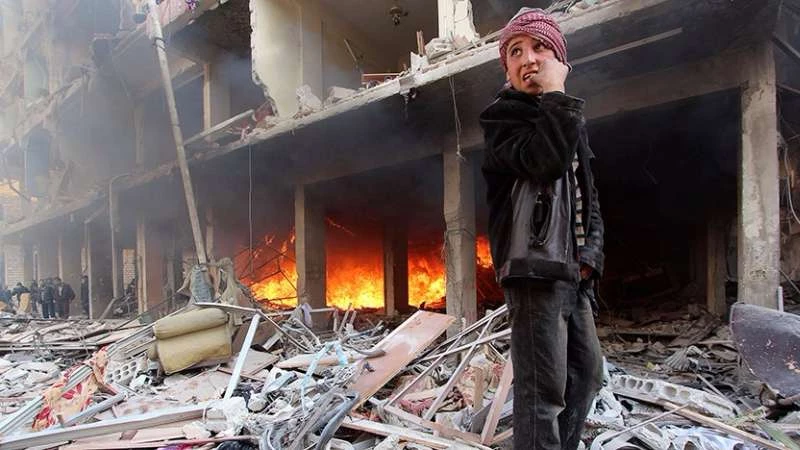To call something post traumatic carries with it the implication that the crisis or event that caused the trauma is in the past; but there is nothing past tense about the horrific events being experienced by a large number of Syria’s children.
“It feels insufficient to say that children from Syria are suffering from “PTSD”,” wrote Charles Davis in article for ATTN published on February 24. “…these children of war have experienced more trauma — physical and emotional — than the medical professionals who care for them have ever seen; the shredded remains of their mom or dad blown apart by a regime barrel bomb, a Russian cruise missile, or, increasingly, U.S. airstrikes.”
The inadequacy of current frames of reference to describe the plight of Syria’s children has led Dr. M.K. Hamza, a neuropsychologist with the Syrian-American Medical Society (SAMS), to come up with his own term for what he has been seeing in the children he has treated; “human devastation syndrome.”
“We have talked to so many children, and their devastation is above and beyond what even soldiers are able to see in the war,” Hamza told ATTN.
“They have seen dismantled human beings that used to be their parents, or their siblings. You get out of a family of five or six or 10 or whatever — you get one survivor, two survivors sometimes. A lot of them have physical impairments… amputations… severe injuries. And they’ve made it to the refugee camp somehow.”
The 1000 doctors of SAMS who have been working as volunteers providing medical care to the wounded inside Syria, as well as victims now living as refugees outside the country, have had their hands full with no letup of the violence in sight.
“You have children who are devastated,” Hamza told ATTN, “and this is not the end of it.”
Syrian refugees living in the countries that border Syria are more often than not struggling just to survive and many parents find themselves in the difficult position of depending upon the exploitation of their children for their family’s survival in places where employment is not only difficult to find, but illegal.
“Even the word ‘poor’ is not justifiable here because it’s a less than human condition,” Hamza told ATTN when describing the conditions that hundreds of thousands of Syrians are now forced to live in.
“I have patients who tell me they were touched inappropriately by their doctors,” Dr. Iyad Alkhouri, a psychiatrist who volunteers with SAMS said while addressing attendees of their recent conference held in California on February 18.
“The doctors, because “And then you tell their parents: Why don’t you send them to school so they can improve themselves? And they say, ‘They make $ 50 a day. Can you give me $ 50 a day?’” In June of 2014, three years and three months after the revolution began in Syria, the U.N. Secretary-General stated in an annual report called “Children and Armed Conflict” that Syria was one of the most dangerous places in the world to be a child. In the years that have followed, the situation has not only gotten worse for those children living in the areas under siege by the Assad regime — especially with the addition of Russian bombs since September 2015 — but the dangers to refugee children living outside the country have increased as well. “Whatever we’re doing is just a Band-Aid,” Dr. Anas Moughrabieh, an intensive-care physician who is also a member of SAMS, told ATTN. Moughrabieh has treated wounded Syrians who were evacuated to Turkey in addition to training medical workers who went back into Syria to treat victims of the bombing and shelling there. “We try to fill the gaps,” he said, “but all the relief organizations — we’re just putting a Band-Aid on the wound. We’re not addressing the root cause of the problem.” The root cause of the problem continues to be what it was from the beginning of the people’s uprising that initially called for reforms from a government rife with tyranny and corruption. Instead of addressing the people’s legitimate complaints, Assad used them as an excuse to launch a brutal war upon his own people with the ultimate goal of changing the demographics of the country in his favor. Following in the manor of other scurrilous leaders of the twentieth century, child victims of Assad’s war are not collateral damage but an intentional component of his ruthless campaign that has deliberately targeted homes, schools, hospitals and even playgrounds. “Children are not just getting caught in the crossfire, they are also likely to be specific targets,” Graça Machel, the Secretary-General’s Special Representative, declared in the first U.N. “Children in War” report in 1996. “When ethnic loyalties prevail, a perilous logic clicks in,” she continued. “The escalation from ethnic superiority to ethnic cleansing to genocide, as we have seen, can become an irresistible process. Killing adults is then not enough; future generations of the enemy — their children — must also be eliminated.” Assad has repeatedly tried to justify his targeting of civilians by claiming he is fighting terrorists. His definition of a “terrorist” is a broad one that includes not only adults who oppose him, but also infants and children who have the potential to oppose him when they grow up — so he has no problem making sure that they won’t.



التعليقات (0)